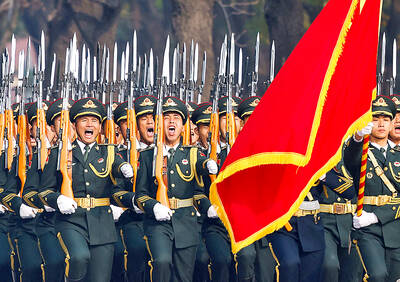Despite repeated displays of goodwill by the government of President Ma Ying-jeou (馬英九) since it came to power in 2008, China’s military preparations for an attack on Taiwan continue to accelerate, a report by the Ministry of National Defense’s intelligence research branch says.
The report says China’s military preparedness for an attack on Taiwan has never been relaxed and that if the People’s Liberation Army (PLA) launched a missile attack on Taiwan, it would destroy more than 90 percent of the nation’s political, economic, military and civil infrastructure. It also predicts the number of Chinese missiles aimed at Taiwan could reach 2,000 by the end of the year.
Although the government’s pro-Beijing policies have been strongly criticized domestically, the ministry’s decision to post the internal research report on its official Web site has raised eyebrows.
Lin Cheng-yi (林正義), a researcher at the Institute of European and American Studies at Academia Sinica, said following Ma’s accession to power, China has moved its military exercises from the coastal areas of Fujian Province to other parts of the country and that it no longer uses Hong Kong media to attack Taiwan.
Lin said that while this was intended to create a more relaxed atmosphere, in reality China’s military threat is constantly growing. The ministry sees through the smokescreen, continues to keep track of China’s military posture and therefore is remaining true to its responsibilities, Lin said.
Although China has reduced the number of military exercises simulating an attack on Taiwan, its activities in the South China Sea and in the waters north and east of Taiwan have been increasing, Lin said.
The report said that a June 1993 meeting of China’s Central Military Commission readjusted its strategic goals, unambiguously making Taiwan its main potential adversary.
Despite Ma’s rapprochement policies, top PLA leaders continue to emphasize in internal meetings that the use of military force must remain an option, the report says.
The PLA’s short and mid-term missile production plans have not been affected by detente in the Taiwan Strait, the report says, adding that the PLA’s missile arsenal targeting Taiwan could reach 1,960 before the end of the year.
A large number of recently decommissioned fighter aircraft have been turned into pilotless drone planes to be used together with Harpy anti-radar unmanned aerial vehicles purchased from Israel. These could help China punch holes in Taiwan’s air defense systems and destroy key targets.
China is focusing resources on developing satellite technology, the report says, adding that the number of Chinese satellites would surpass 60 before the end of this year. Of these, 14 would be Jianbing (尖兵) and Leidian (雷電) military surveillance satellites. The total would also include 15 Shentong (神通) and Fenghuo (烽火) military communication satellites, Xinnuo (鑫諾) broadcasting satellites and 16 Beidou (北斗) navigation satellites. These satellites will help the PLA wage integrated warfare and improve weapon accuracy.
The strength of the PLA Navy is also increasing. Its regular amphibious abilities have also increased, with transport capacity reaching a full division.

Conflict with Taiwan could leave China with “massive economic disruption, catastrophic military losses, significant social unrest, and devastating sanctions,” a US think tank said in a report released on Monday. The German Marshall Fund released a report titled If China Attacks Taiwan: The Consequences for China of “Minor Conflict” and “Major War” Scenarios. The report details the “massive” economic, military, social and international costs to China in the event of a minor conflict or major war with Taiwan, estimating that the Chinese People’s Liberation Army (PLA) could sustain losses of more than half of its active-duty ground forces, including 100,000 troops. Understanding Chinese

The Ministry of Foreign Affairs (MOFA) yesterday said it is closely monitoring developments in Venezuela, and would continue to cooperate with democratic allies and work together for regional and global security, stability, and prosperity. The remarks came after the US on Saturday launched a series of airstrikes in Venezuela and kidnapped Venezuelan President Nicolas Maduro, who was later flown to New York along with his wife. The pair face US charges related to drug trafficking and alleged cooperation with gangs designated as terrorist organizations. Maduro has denied the allegations. The ministry said that it is closely monitoring the political and economic situation

UNRELENTING: China attempted cyberattacks on Taiwan’s critical infrastructure 2.63 million times per day last year, up from 1.23 million in 2023, the NSB said China’s cyberarmy has long engaged in cyberattacks against Taiwan’s critical infrastructure, employing diverse and evolving tactics, the National Security Bureau (NSB) said yesterday, adding that cyberattacks on critical energy infrastructure last year increased 10-fold compared with the previous year. The NSB yesterday released a report titled Analysis on China’s Cyber Threats to Taiwan’s Critical Infrastructure in 2025, outlining the number of cyberattacks, major tactics and hacker groups. Taiwan’s national intelligence community identified a large number of cybersecurity incidents last year, the bureau said in a statement. China’s cyberarmy last year launched an average of 2.63 million intrusion attempts per day targeting Taiwan’s critical

AGING: As of last month, people aged 65 or older accounted for 20.06 percent of the total population and the number of couples who got married fell by 18,685 from 2024 Taiwan has surpassed South Korea as the country least willing to have children, with an annual crude birthrate of 4.62 per 1,000 people, Ministry of the Interior data showed yesterday. The nation was previously ranked the second-lowest country in terms of total fertility rate, or the average number of children a woman has in her lifetime. However, South Korea’s fertility rate began to recover from 2023, with total fertility rate rising from 0.72 and estimated to reach 0.82 to 0.85 by last year, and the crude birthrate projected at 6.7 per 1,000 people. Japan’s crude birthrate was projected to fall below six,